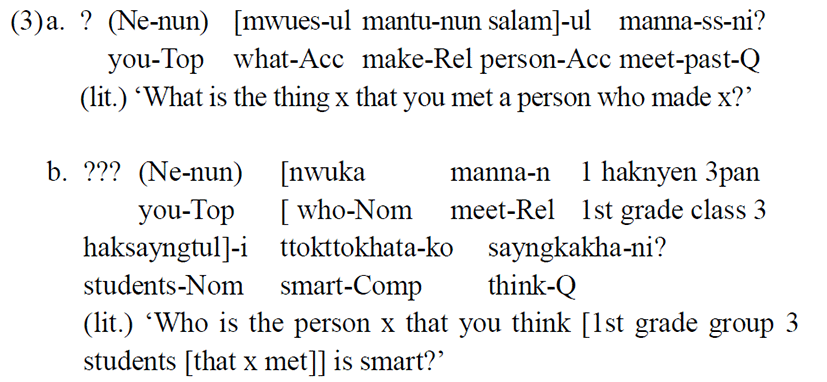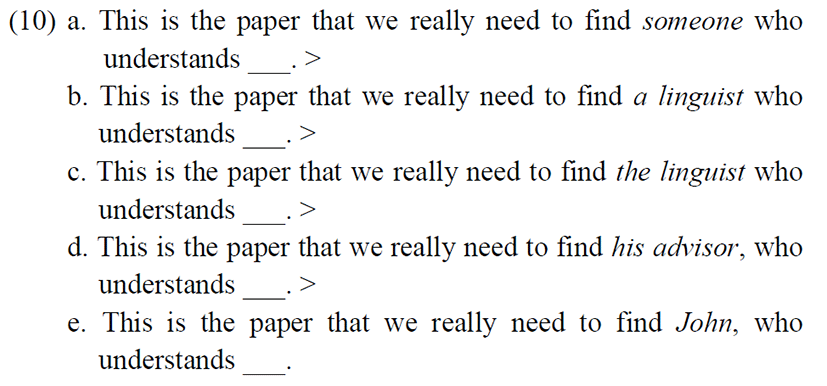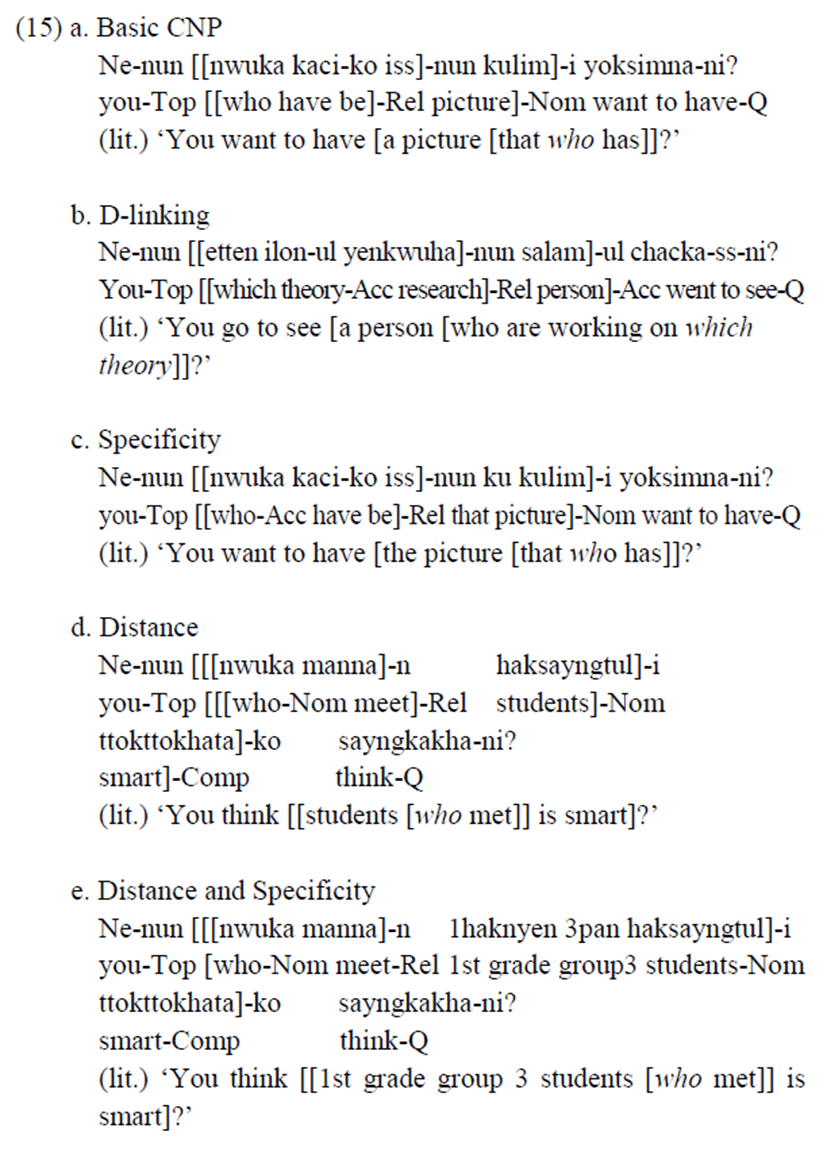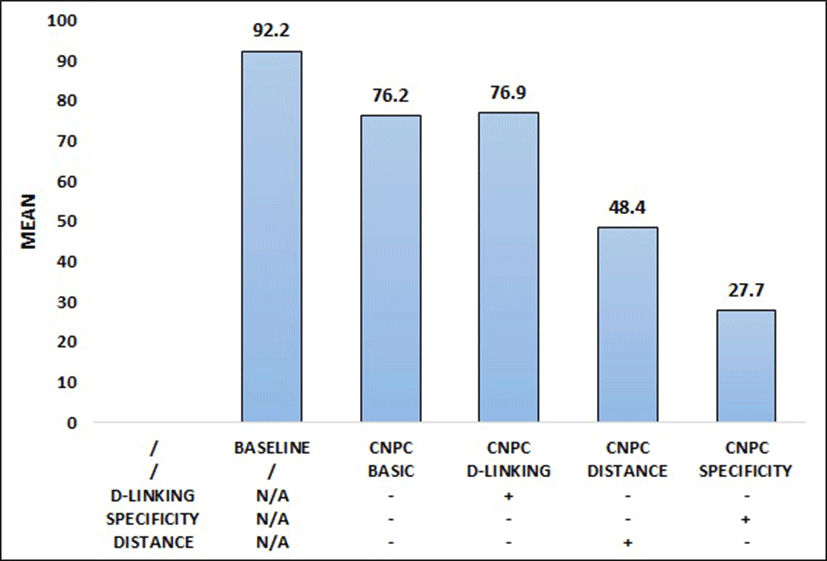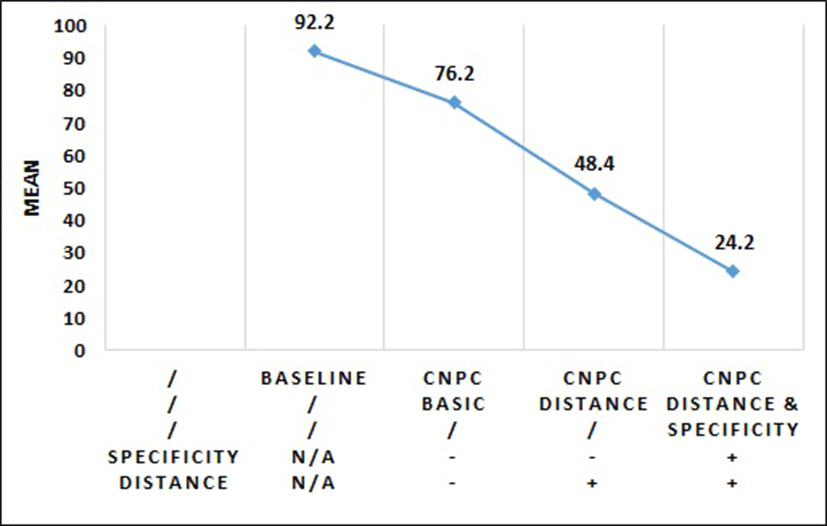1. Introduction
Since Chomsky (1962), Island effects have been considered paradigmatic evidence for movement, playing an important role in developing generative grammar. Despite disputes regarding various approaches to explaining these effects in the framework of generative grammar, it has been generally agreed upon that Islands are effective against movement. In this respect, the standard syntactic assumption about Island effects of wh-in-situ questions in Korean has been that they do not show such effects. For instance, unlike the overtly moved wh-phrases as in (1), the following sentence with a wh-phrase in the complex noun phrase Island does not seem to show any Complex Noun Phrase Constraint (hereafter, CNPC) effects as in (2).1
A closer look, however, reveals that not all wh-in-situ questions violating CNPC in Korean are equally acceptable, as we can see in the rather degraded status of the following sentences:
In fact, some of the sentences violating the CNPC in Korean appear to be quite unacceptable, as we see in (3b). These kinds of less-than-perfect/acceptable instances of CNPC violations have been mostly ignored, either consciously or unconsciously, in the discussion of CNPC effects in Korean, as most syntacticians typically cite good cases such as (2) to show the absence of CNPC effects. Given this state of affairs, an obvious question we should ask is why we should base our claim about the existence or absence of CNPC effects of Korean wh-in-situ questions on the acceptability of sentences like (2), rather than on the degraded status of (3), simply concluding that there are no CNPC effects.
Interestingly, the acceptability of overt wh-movement questions violating the CNPC also varies considerably from unacceptable to quite acceptable as in the wh-in-situ questions in (2) and (3) (Hofmeister & Sag 2010).2
If violations of a given grammar rule, say the CNPC, do not necessarily produce complete unacceptability in languages with overt movement as in (4a), and if the relevant CNP constructions without overt movement exhibit gradient acceptability as in (3), it is not easy to maintain that CNPC effects are explained by grammatical constraints triggered by movement operations. Moreover, we can also ask whether the claim in the syntactic literature can be justified with regard to only wh-phrases in overtly moved wh-phrases show CNPC effects, while those in wh-in-situ languages do not.
Given these sets of data, this paper aims to explore the following questions which have rarely been asked in the literature on Korean syntax: 1) is it true that wh-in-situ questions in Korean do not show CNPC effects? 2) if wh-in-situ questions violating the CNPC in Korean do show variations in acceptability, what is the source of these variations, in other words, the gradient nature of acceptability? 3) if there are any factors responsible for gradient acceptability in Korean, are they related in any respect to the already discussed intervening factors for CNPC effects in overt wh-movement languages? and 4) what makes general differences in acceptability of CNP related data between languages with overt wh-movement and those without? To answer these questions, we first examined, through an experimental study of Korean native speakers, if there really exists a wide range of variation in the acceptability of wh-in-situ questions violating the CNPC in Korean, as we have suspected, and if so, what kind of factors are responsible for it?
In the experiment, we found our suspicion to be amply verified. We found that the range of acceptability varied widely from quite acceptable to somewhat acceptable to quite unacceptable, as an indication of its gradient nature. We also found that affecting their acceptability are various factors such as distance, semantic complexity, and specificity, which are known to affect the acceptability of overt wh-movement questions and also that the effects of these factors are cumulative. We interpret these results showing the processing nature of CNPC effects. According to the processing approach, Island effects arise when the processing load for handling a sentence with a long-distance dependency gets too heavy between the dislocated filler and its gap (Fodor 1983, Frazier & Clifton 1989, Just & Carpenter 1992, Kluender & Kutas 1993, etc). This claim, crucially, is based on the fact that the Island effects are gradient and that the acceptability of the questions involving the wh-movement is determined by various factors such as distance or referential specificity. The fact that the same is true of wh-in-situ questions, i.e., that the acceptability is gradient, and that the same processing factors known to affect the acceptability of overt wh-movement questions are also responsible for the variation in acceptability, will lead us to conclude that CNPC effects of wh-in-situ in Korean are also processing in nature.
This paper is organized as follows. Section 2 reviews two bifurcated approaches to Island effects, one as a violation of a principle (principles) of competence grammar and the other as a result of processing difficulties. Section 3 introduces an acceptability judgment experiment of wh-in-situ questions in Korea violating the CNPC and discusses its results. Section 4 presents factors that affect the acceptability wh-phrases in CNP constructions and discusses that which causes differences between overt wh-movement and wh-in-situ with respect to CNP Island effects.
2. Stories of Islands
Since Ross (1967) introduced the term ‘Island’ to refer to a configuration to block extraction out of it, various proposals have been made regarding ways to capture its definition and its effects.3 Over the past 50 years, generative grammar has provided powerful theories that capture Island effects as a part of competence grammar. On the other hand, relatively recent developments on this issue have paid attention to the ‘gradient’ nature of the effects and attributed detected deviance to the processing cost that depends on the rate of aggregate difficulty.
It was the A-over-A Condition of Chomsky (1962) that first introduced a condition on syntactic application to the syntactic literature to define a domain from which extraction is banned. It states that an element of category such as NP cannot be extracted over the same category NP as in (6).
Pointing out problems of undergeneration in the A-over-A condition, Ross (1967) introduced the term ‘Island’ describing the phenomena with more specific terminology such as the CNPC among others.4 According to (7), anything that is in a sentence dominated by a NP cannot be moved out of it; in this sense, the CNP is an Island.
There have been subsequent proposals to deal with the phenomena under the generative grammar framework such as the Subjacency Condition (Chomsky 1973), Barriers (Chomsky 1986) and the Minimal Link Condition (Chomsky 1995), among others.5 Though the details of defining syntactic Islands vary, none are free from the prediction that, as far as they are syntactic conditions imposed on movement operations, they would not allow movement operations at all if the data in question fit in with the given syntactic configurations. However, the acceptability status of the relevant constructions with a syntactic Island is not dichotomous but gradient in nature.6 In fact, Chomsky (1973) himself mentioned that there is a gradation of acceptability among sentences with the same grammatical structures. (8b) is worse than (8a) but better than (8c).
Ross (1967) also acknowledged that a wh-question in (9) that fit in with his CNPC configuration indeed sounds better than other CNPC violation sentences such as (6).
Despite such recognition of counterexamples or the data with graded acceptability, purely syntactic approaches to Island effects have treated them as minor peripheral cases, failing to provide a satisfactory account for them.
Providing various data with gradient acceptability, there has been a series of studies done to attribute the degraded nature of the so-called Island effects to accumulated processing difficulty driven above a threshold, which we call the processing approach (Fodor 1983; Kluender 1992, 1998; Hawkins 1999; Sag & Wasow 1997; Hofmeister & Sag 2010, etc). According to the processing approach, a dislocated wh-phrase itself, which is called filler, is not easy to process from the beginning as its thematic role and grammatical function are not assigned in the dislocated position; hence it needs to be held in the working memory until its gap position is identified. At the same time, being an element without its phonological content, the gap for the dislocated filler is not easily identified. Therefore, a sentence with a filler-gap dependency path itself costs more than one without such paths. Moreover, if there are many intervening elements and complex structures such as Islands to parse between the filler and its gap, processing of all the materials on the path from filler to the gap becomes more costly as processing burdens along the filler-gap path increase (Hawkins 1999, Warren & Gibson 2005, Hofmeister & Sag 2010).7 Obviously, the processing approach can give explanations on gradient acceptability of given sentences as it assumes that increased processing difficulty lowers the acceptability and those factors causing processing difficulty work cumulatively.
For instance, by showing various degrees of acceptability of the following sentences with CNP constructions, Kluender (1992) claims that the gradient nature of CNPC effects shown in (10) can be explained in terms of the cumulative referential processing load of a sentence, which is from violation of the predication principle in (11):8
Because specific/definite NPs contain more lexical information than less specific ones, they demand more cost on processing. Therefore, the more specific an intervening constituent along a filler-gap path is, the heavier the processing burden becomes, and therefore more seriously violates the Predication Principle. Increased processing burden leads to lower acceptability judgements (Deane 1991, Warren & Gibson 2002).
There are other factors involved in processing sentences with CNPC effects according to the processing approach, including distance between the filler and its gap and the complexity of the filler. Regarding the distance factor, Gibson & Pearlmutter (1998: 265) claim that the greater the distance between an incoming word and the head or dependent to which it attaches, the greater the integration costs. As the filler-gap path becomes longer, it is more difficult to access the memory item because the activation of a mental representation decays overtime. When we apply this factor to the CNPC construction, all other things being equal, wh-interrogatives crossing the CNP boundary are likely to have a longer path than those without any CNP boundary between the filler and its gap.9
The complexity of the filler is also relevant in relation to processing costs. Vasishth & Lewis (2006) claims that semantically richer filler promotes increased acceptability as processing such an element pre-activates the representation it depends on in memory, making it easier to access the representation. The richer the filler is, the more easily its reference can be established in mental representation and, accordingly, the better it can be held in working memory. Hofmeister & Sag (2010) also argue that semantically richer wh-phrases such as which paper in (13a) narrow down the list of candidate answers that have to be considered as opposed to what in (13b), reducing the processing load.
In sum, the processing approach provides a better explanation on the gradient nature of CNPC effects, showing that different degrees of acceptability status can be explained in terms of different degrees of processing burden.
The aforementioned previous literature on Island effects has focused on the gradient nature of the effects with overtly moved phrases. In the purely syntactic approach, the conditions apply to movement operation, preventing an element from escaping from a certain structurally defined environment such as CNPs or more generally Islands. If there is no movement, the given syntactic condition is inoperative. It leads to a prediction that there are no CNPC effects in wh-in-situ languages.
There is a school of thought claiming that there are certain, somewhat covert types of in-situ-wh-phrase movement operations at LF. For instance, according to Huang (1982) who first extended the movement approach of this sort to wh-in-situ in languages like Chinese, a wh-in-situ phrase does undergo movement in order to receive a proper interpretation at LF, but it is predicted not to show any Island effects. This is because the LF movement, unlike the S-structure movement, is not subject to the locality restrictions such as subjacency. Alternatively, there has been a group of scholars who argued that wh-questions in wh-in-situ languages are interpreted in a completely different manner. Their interpretations come from unselective binding of wh-phrases by Q(or the Q-particle), which checks the Q feature in C (Li 1992, Aoun & Li 1993, Tsai 1994, Cole & Hermon 1998, etc.).10 Since unselective binding is not a movement operation, Island effects are not expected in this approach either. In fact, when it comes to the Island effects of in-situ wh-phrases, the focus of research in the syntactic literature has been given to explaining the differences in various types of Island effects, so-called selective Island effects. For instance, wh-in-situ phrases in Korean and Japanese do show wh-Island effects although they do not show Complex NP Island effects and Adjunct Island effects.11 The covert pied-piping approach of Nishigauchi (1986), based on feature percolation, can distinguish the former from the latter such that the wh-phrase percolates its feature all the way to the head noun of CNPs, while it cannot do so in wh-Islands. Hence the pied-piped CNP itself moves covertly without violating Island constraints in CNP constructions. On the other hand, wh-features cannot be percolated up to the embedded wh-Islands due to the embedded C with Q feature.12 In Chinese, however, there are no Island effects at all regardless of types of Islands including wh-Islands.
What needs to be noted here is that, as far as strong Islands such as CNP Islands are concerned, it has been agreed that wh-in-situ languages do not show Island effects as discussed. In addition, not much attention has been given to the gradient nature of the wh-Island effects of wh-in-situ if there are any.
In the processing approach, processing burden is calculated based on filler-gap dependency links measuring factors that cause processing difficulties such as the distance between the filler and its gap (or length of the filler-gap path), complexity of the filler phrases, and specificity of intervening elements between the filler and its gap. If there is no overt movement, there will be neither fillers nor gaps. Unless we assume the existence of other dependency links that behave similarly to the filler-gap path, i.e., unless there is some other source of processing loads in wh-in-situ questions, wh-in-situ will not show CNPC effects.
In what follows, we report results of an experiment to investigate how CNPC effects-related data are judged by native Korean speakers and what are the relevant factors responsible for the different judgments.
3. Gradience in the Acceptability of Korean Wh-in-situ Questions with a CNPC Violation
Thirty four undergraduates at Sejong University in Seoul, Korea participated in the experiment for course credit. All were native speakers of Korean studying English language and literature. They were taking an introduction course in English linguistics but none were aware of syntactic Island constraints.
The experiment was designed to investigate whether or not there are any CNPC effects in Korean, and what causes the effects, if any. Based on the claims of the processing approaches to the CNPC effects in overt wh-movement, three factors — i.e., distance between a wh-phrase and the Q(uestion) particle, specificity of the head noun of CNPs, and semantic complexity of in-situ wh-phrase (D-linking) — are tested with respect to their effects on CNPC violations. If wh-in-situ languages such as Korean do show CNPC effects, and there is gradience the in acceptability status of in-situ wh-interrogatives in CNPs, it will be worthy to check whether the factors responsible for the variations in the CNPC Effects in Korean are the same as those in overt wh-movement languages. Given that processing of wh-in-situ questions will be different from that of overt wh-movement questions, we expect that manipulating these factors in wh-in-situ questions in Korean should yield a processing burden distinct from that in overt wh-movement languages and accordingly that it will result in different acceptability status of the sentences in question. To be specific, our predictions are that there are variations in the acceptability status in wh-in-situ questions with CNPC violations in Korean and that the same factors responsible for processing filler-gap dependency in overt wh-movement will affect processing of wh-in-situ questions.
Sentences with a CNPC violation and those without it were tested for their acceptability in this experiment. As for the sentences with a CNPC violation, there were five patterns tested in the experiments, which varied with respect to the content of the wh-phrases (CNPs with D(iscourse)-linked wh-phrases), the properties of head NPs (head nouns of CNPs with specificity), the distance between the filler and its gap (three clausal boundaries between wh-phrases and Q-particles), CNPs with both a specificity factor and a distance factor, and those with none of these three factors (basic CNPs). Sample experimental items of the five patterns are illustrated in (15).
All items were pseudo-randomized so that the related factors did not appear consecutively. An acceptability rating task was presented as a paper survey. Yes-no questions, ungrammatical (case-marker-wise) interrogatives and declaratives with comparable sentence length were added to the survey list so that the participants did not know what the target patterns were. The task was a 5-point scale acceptability judgement task where 1 represented “least acceptable” and 5 represented “most acceptable”. Participants were under no time constraints during the survey.
Each participant’s ratings were transformed to a percentile scale. The results show that acceptability ratings of sentences with in-situ wh-phrases in CNPs vary widely depending on factors that affect the processing complexity of wh-phrases in Islands.
The mean of the acceptability judgments of the tested sentences are shown in Table 1 with a percentile scale:
| Factors | Mean | SD |
|---|---|---|
| Baseline | 92.2 | 13.38 |
| Basic CNP | 76.2 | 24.67 |
| D-Linking (of in-situ wh-phrases) | 76.9 | 18.17 |
| Specificity (of head nouns) | 27.7 | 17.68 |
| Distance (between wh-phrase and Q-particle) | 48.4 | 22.76 |
Table 1 displays descriptive statistics for students’ acceptability on the sentences with three processing factors such as base Islands, d-linking, specificity, and distance. Average acceptability was computed for the items that measure the same processing factors. Baseline sentences without CNP Islands were considered as a reference. In order to see the effects of the processing factors on acceptability levels, repeated measures ANOVA was conducted using SPSS 18.0. Findings indicate that the effects were significantly different (F = 53.451, df = 4,124, p < 0.001). This indicates that students’ acceptability level was different according to the processing factors that the sentences contain. Post-hoc analyses showed that the difference was attributed to all the paired comparisons except for Basic CNP vs. D-linking factors. In other words, the acceptability level was significantly different at α2 = 0.05 for all the pairs except for Basic CNP vs D-linking.
The results of the experiment showed that the acceptability of the wh-in-situ questions violating the CNPC in Korean varies widely, from the lowest test sentence with a value of 24.2% to the highest sentence at 82.8%. As indicated in Figure 1 with mean percentile values for each set, a canonical CNPC violation example employed to show the lack of the CNPC effects in wh-in-situ languages was rated relatively high (76.2% as their mean value) but lower than sentences without any Island constraint violation (92.2% mean value).
The basic CNP sentences received higher ratings than other CNP sentences with specificity effects and the distance factor added to the Islands; the specificity of the head noun and distance between wh-phrases and Q-particles degraded acceptability. More specifically, the acceptability scale dropped from 76.2% to 48.4% when the wh-phrase was deeply embedded such that the distance between the wh-phrase and Q-particle at the end of the sentence became larger, indicating that increasing dependency distance reduces acceptability. When the head of the CNP is specific, the acceptability dropped drastically from 76.2% to 27.7%, showing that when processing of the intervening constituent (in our case, the head noun of the CNP) consumes more resources by being definite, the acceptability is degraded. In general, definite NPs refer to established referents in the discourse, triggering a search for their referents. Hence, in order to parse, extra processing cost needs to be paid compared to that of indefinite NPs.
As for the effects of D-linking, some rather surprising results were found in the comparisons between basic CNP sentences and CNP sentences with D-linked wh-phrases. Contrary to our expectation, there was only a minor increase in acceptability status when the wh-phrase was D-linked from 76.2% to 76.9%. At the moment, there is no clear explanation for this.
When factors that affect the processing load are cumulated, the acceptability is worsened as expected. Figure 2 shows the cumulative effects of processing factors. When the wh-phrase is deeply embedded and the head noun of the CNP is specific, the sentence received the lowest score for its acceptability (24.2%).
Recall that there were research questions raised in this paper with respect to CNPC effects in Korean. The result of the experiment, first of all, verifies our impression about CNPC effects of Korean wh-in-situ questions: not all wh-in-situ questions in the CNP configurations in Korean are equally acceptable, rejecting the claim that there are no CNPC effects at all in Korean where wh-phrases do not have to move overtly. The ensuing question is as follows: if there is degraded acceptability of wh-in-situ questions violating the CNPC in Korean, to what does this gradient nature owe its character? The results of the experiment indicate that distance between the wh-phrases and the Q particle responsible for its interrogative interpretations matters. In addition, the properties of the head noun located between the wh-phrase and the Q particle affect the acceptability; the specificity of an intervening NP incurs more processing costs, thereby degrading the acceptability.
To summarize, the results of our experiment show that the factors responsible for gradient acceptability in wh-in-situ questions violating the CNPC in Korean are almost the same as those previously identified for the comparable sentences in overt wh-movement languages. The only difference found in the current experiment is that, in languages with overt wh-movement, semantic complexity of the filler (D-linking) does increase the acceptability of CNPC violated sentences, while in Korean, the D-linking effects were somewhat trivial.
4. Concluding Remarks: Differences in CNPC Effects Between Overt Wh-movement Questions and Wh-in-situ Questions
The standard assumption about CNPC effects is that overt wh-movement questions show the effects while wh-in-situ questions do not, and explaining this difference has been one of the much-discussed issues in the theory of movement. Contrary to the previous claim based on movement theories, we have shown that the acceptability of wh-questions violating the CNPC shows a wide range of variations not only in overt wh-movement languages but also in wh-in-situ languages. This implies that in both types of languages, processing costs affect the acceptability status of the sentences with CNP configurations. We have seen that the cost is cumulative and the results become worse if more factors causing processing difficulty are involved.
This explanation, in turn, leads us to the original question stated at the outset of this paper: why the standard syntactic assumption about the CNP Island effects of wh-in-situ in Korean is that they do not show CNPC effects, unlike the overtly moved wh-phrases in languages such as English. In overt wh-movement languages, the filler is dislocated and there is an empty gap that needs to be identified. The dislocated wh-phrase, whose thematic role and grammatical function are unassigned, must be held in the working memory until the gap is identified, and this process, naturally, will increase the processing load of a sentence with a filler-gap dependency. Processing loads incurred by wh-in-situ questions in Korean will be lower. This is because the dependency here is not the filler-gap dependency, but rather the semantic linking between the wh-phrase and the Q particle. Given that much of the processing loads for overt wh-movement questions come from holding the filler in working memory, we can surmise that processing loads will be lower in wh-in-situ questions. We suggest that this difference in the cumulative processing loads between overt wh-movement questions and wh-in-situ questions is translated into the presence or absence of CNPC effects in two types of movement languages.



